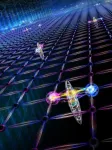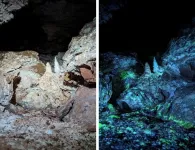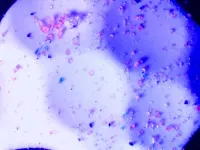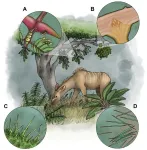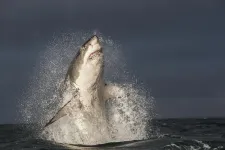(Press-News.org) In vertebrate retinas, specialized photoreceptors responsible for color vision (cone cells) arrange themselves in patterns known as the “cone mosaic”. Researchers at the Okinawa Institute of Science and Technology (OIST) have discovered that a protein called Dscamb acts as a "self-avoidance enforcer" for color-detecting cells in the retinas of zebrafish, ensuring they maintain perfect spacing for optimal vision. Their findings have been published in Nature Communications.
Solving a mystery in vision science
Vertebrate retinas contain photoreceptor cells that convert light into neural signals. These photoreceptors come in two main types: rods, which function in dim light, and cones, which function in bright light and provide color vision. The cones themselves are further subdivided into different types based on the specific light wavelengths they detect. In zebrafish there are four types: red, green, blue, and UV cone cells.
The cone mosaic refers to the highly organized spatial arrangement of these different cone types across the surface of the retina. Rather than being randomly distributed, cone cells of the same type keep specific distances from each other and form recognizable patterns with other cone types. This creates a mosaic-like appearance when the retina is viewed from the surface.
In zebrafish, the four cone types are assembled to form a lattice-like regular cone mosaic pattern. This intricate cone mosaic pattern in fish species was reported in the latter 19th century. However, the molecules that directly regulate the formation of the cone mosaic pattern had not been identified across vertebrate species.
Creating zebrafish cone mosaic-defective mutants
DSCAM (Down Syndrome Cell Adhesion Molecule) is a protein that helps nerve cells connect properly during development. It was first found in humans on chromosome 21, which is linked to Down Syndrome. DSCAM proteins exist in many animals and help nerve cells form neural circuits without tangling into themselves. Zebrafish have three versions of this protein: Dscama, Dscamb, and DscamL1. Only Dscamb is found in the light-sensing cells of the developing zebrafish eye.
“Because DSCAM regulates a self-avoidance mechanism in nervous system development, we genetically modified zebrafish to lack functional Dscamb protein to test our hypothesis that this protein is involved in cone mosaic formation,” explained Dr. Dongpeng Hu, former PhD student at OIST’s Developmental Neurobiology Unit and first author. “We found that the cone mosaic pattern, especially red cone arrangement, is disrupted in zebrafish Dscamb mutants.”
Same-cell recognition shapes vision
In the early stage of photoreceptor differentiation in zebrafish, cone photoreceptors were reported to extend thin projections called filopodia from their apical regions; however, their physiological role in photoreceptor differentiation was unknown. To clarify the role of Dscamb in cone mosaic formation, the researchers used fluorescent tagging techniques to visualize where Dscamb proteins are located within cells. Surprisingly, Dscamb proteins are localized in the apical regions including the tips of filopodia-like projections of cone photoreceptors.
The researchers examined behaviors of red cone filopodia. Through time-lapse imaging, they discovered that red cones extend these filopodia to neighboring red cones, briefly make contact, and then retract in wild zebrafish. On the other hand, such contact-dependent retraction of red cone filopodia was not observed in neighboring non-red cones. This dynamic process gradually establishes proper spacing between red cones of the same type. In Dscamb mutants, however, red cone filopodia failed to properly retract after contact with the same red cone-type and instead remained attached or even invaded the apical surface of neighboring red cones. This leads to abnormal red cone clustering and disrupted mosaic patterns.
Therefore, the apical filopodium of cones function as antennae to probe their environment and sense whether neighboring cones are the same type or not. When the filopodia from one red cone contact another red cone, Dscamb proteins interact, triggering a repulsive response that causes the filopodia to retract. This self-avoidance mechanism ensures that red cones maintain proper spacing from each other.
Furthermore, this self-avoidance mechanism is specific to interactions between cones of the same type: red cones recognize and respond to other red cones, and similarly for blue cones with other blue cones. Interestingly, the scientists found that Dscamb specifically regulates the spacing of red cones, while the mechanism for similar spacing between blue cones appears to be independent of Dscamb. Therefore, Dscamb functions as a sensor to recognize the same red cone-type during cone mosaic formation in zebrafish.
Implications for vision research
“Our computer analysis and modeling confirmed that this recognition and repulsion mechanism for the same types of cells could explain the observed cone mosaic patterns. This represents the first identification of a molecular mechanism directly regulating cone mosaic formation in any species, opening potential avenues for understanding similar processes in other vertebrates,” Prof. Ichiro Masai, head of OIST’s Developmental Neurobiology Unit, emphasized.
The discovery of Dscamb's role in zebrafish cone mosaic formation has important implications for vision research. It shows the molecular basis for precise photoreceptor spacing crucial for optimal vision and creates opportunities for investigating similar mechanisms in human retinal disorders. This knowledge could potentially advance diagnostic approaches, treatment options, and retinal regeneration strategies.
END
Study shows how retinal cells know when to keep their distance
Key molecule behind precise photoreceptor organization identified in fish
2025-03-25
ELSE PRESS RELEASES FROM THIS DATE:
New type of quantum computer studies the dance of elementary particles
2025-03-25
The standard model of particle physics is our best theory of the elementary particles and forces that make up our world: particles and antiparticles, such as electrons and positrons, are described as quantum fields. They interact through other force-fields, such as the electromagnetic force that binds charged particles.
To understand the behaviour of these quantum fields and with that our universe, researchers perform complex computer simulations of quantum field theories. Unfortunately, many of these calculations are too complicated for even our best supercomputers and pose great challenges for quantum computers as well, leaving many pressing ...
AI can help doctors give intravenous nutrition to preemies, Stanford Medicine study finds
2025-03-25
Artificial intelligence can improve intravenous nutrition for premature babies, a Stanford Medicine study has shown. The study, which will publish March 25 in Nature Medicine, is among the first to demonstrate how an AI algorithm can enable doctors to make better clinical decisions for sick newborns.
The algorithm uses information in preemies’ electronic medical records to predict which nutrients they need and in what quantities. The AI tool was trained on data from almost 80,000 past prescriptions for intravenous nutrition, which was linked to information about how the tiny patients fared.
Using AI to help prescribe IV nutrition could reduce medical errors, ...
New study uncovers key pathways in hydronium and hydroxide ion neutralization
2025-03-25
A new study provides fresh insight into traditional acid-base chemistry by revealing that the mutual neutralization of isolated hydronium (H₃O⁺) and hydroxide (OH⁻) ions is driven by electron transfer rather than the proton transfer that is expected in bulk liquid water. Using deuterated water ions and advanced 3D coincidence imaging of the neutral products, researchers found two electron-transfer mechanisms that produce hydroxyl radicals (OH), which are crucial in atmospheric chemistry. These findings reshape our understanding ...
ASM and IUMS unveil global framework to implement microbial climate solutions
2025-03-25
Washington, D.C.—As climate change continues to accelerate at an alarming pace, innovative and scalable solutions are more critical than ever. This week, the American Society for Microbiology (ASM) and the International Union for Microbiological Societies (IUMS) released Microbial Solutions for Climate Change, a report developed by their scientific advisory group (SAG) of global experts. The report outlines innovative microbial technologies that can significantly contribute to climate change mitigation and underscores the urgent need for coordinated global action across nations ...
‘Low-sugar’ vaccine can provide broad immunity against coronavirus variants
2025-03-25
SAN DIEGO, March 25, 2025 — Sugar coatings aren’t only for candies; they also help viruses, like the ones that cause COVID-19, hide from their hosts’ immune system. Now, researchers have developed a universal vaccine that targets coronaviruses and the sugars that they use as cover. As demonstrated in animal studies, the vaccine removed sugar molecules from an area of a coronavirus spike protein that rarely mutates and created effective and plentiful antibodies to inactivate the virus.
Chi-Huey Wong, a chemistry professor ...
Chewing gum can shed microplastics into saliva, pilot study finds
2025-03-25
SAN DIEGO, March 25, 2025 — Plastic is everywhere. And many products we use in everyday life, such as cutting boards, clothes and cleaning sponges, can expose people to tiny, micrometer-wide plastic particles called microplastics. Now, chewing gum could be added to the list. In a pilot study, researchers found that chewing gum can release hundreds to thousands of microplastics per piece into saliva and potentially be ingested.
The researchers will present their results at the spring meeting of the American Chemical ...
Fluorescent caves could explain how life persists in extraterrestrial environments
2025-03-25
SAN DIEGO, March 25, 2025 — Deep below Earth’s surface, rock and mineral formations lay hidden with a secret brilliance. Under a black light, the chemicals fossilized within shine in brilliant hues of pink, blue and green. Scientists are using these fluorescent features to understand how the caves formed and how life is supported in extreme environments, which may reveal how life could persist in faraway places, like Jupiter’s icy moon Europa.
The researchers will present their results at the spring meeting of the American Chemical Society (ACS). ACS Spring 2025 is being held March 23-27; it features about 12,000 presentations on ...
Hydrophilic coating makes for unflappable golf balls
2025-03-25
SAN DIEGO, March 25, 2025 — The upcoming U.S. Open has professional golfers and spectators looking forward to getting on the green. But the grass’ condition, regardless of a player’s skill, can drastically skew the chances of a winning putt. Now, scientists can slow the roll of a golf ball on a lightning-fast, dry course and speed it up on a sluggish, wet course thanks to a coating that soaks up water molecules without interfering with the ball’s aerodynamics.
Thomas J. Kennedy III, owner of Chemical Innovative Solutions Inc., will present his results at the spring meeting of the American Chemical ...
New research reveals venomous findings in non-animals
2025-03-25
A new published study reveals plants, fungi, bacteria, protists, and even some viruses deploy venom-like mechanisms, similar to that of venomous snakes, scorpions and spiders, according to researchers at Loma Linda University School of Medicine.
The definition of venom is a biological toxin introduced into the internal milieu of another organism through a delivery mechanism such as a sting or bite that inflicts a wound. According to lead author William K. Hayes, PhD, professor of biology for the Department of Earth and Biological Sciences at the School of Medicine, the findings show that reliance on venom for solving problems like predation, ...
Ecosystem disrupted following the disappearance of Great white sharks, new study finds
2025-03-25
Ecosystem disrupted following the disappearance of Great white sharks, new study finds
Known for their powerful ability to launch out of the water in pursuit of prey, the loss of Great white sharks from False Bay in South Africa has scientists and conservationists concerned about the rippling effects on the ecosystem.
Miami, Florida – A new study published in the journal Frontiers in Marine Science, has uncovered evidence of far-reaching ecosystem consequences following the disappearance of Great white sharks (Carcharodon carcharias) from False Bay, South Africa. The research, conducted by scientists at the University of Miami Rosenstiel ...
LAST 30 PRESS RELEASES:
Structure of dopamine-releasing neurons relates to the type of circuits they form for smell-processing
Reducing social isolation protects the brain in later life
Keeping the heart healthy increases longevity even after cancer
Young adults commonly mix cannabis with nicotine and tobacco
Comprehensive review illuminates tau protein's dual nature in brain health, disease, and emerging psychiatric connections
Book prepares K-12 leaders for the next public health crisis
Storms in the Southern Ocean mitigates global warming
Seals on the move: Research reveals key data for offshore development and international ecology
Sports injuries sustained during your period might be more severe
World's first successful 2 Tbit/s free-space optical communication using small optical terminals mountable on satellites and HAPS
Can intimate relationships affect your heart? New study says ‘yes’
Scalable and healable gradient textiles for multi‑scenario radiative cooling via bicomponent blow spinning
Research shows informed traders never let a good climate crisis go to waste
Intelligent XGBoost framework enhances asphalt pavement skid resistance assessment
Dual-function biomaterials for postoperative osteosarcoma: Tumor suppression and bone regeneration
New framework reveals where transport emissions concentrate in Singapore
NTP-enhanced lattice oxygen activation in Ce-Co catalysts for low-temperature soot combustion
Synergistic interface engineering in Cu-Zn-Ce catalysts for efficient CO2 hydrogenation to methanol
COVID-19 leaves a lasting mark on the human brain
Scientists use ultrasound to soften and treat cancer tumors without damaging healthy tissue
Community swimming program for Black youth boosts skills, sense of belonging, study finds
Specific depressive symptoms in midlife linked to increased dementia risk
An ‘illuminating’ design sheds light on cholesterol
Who is more likely to get long COVID?
Study showcases resilience and rapid growth of “living rocks”
Naval Research Lab diver earns Office of Naval Research 2025 Sailor of the Year
New Mayo-led study establishes practical definition for rapidly progressive dementia
Fossil fuel industry’s “climate false solutions” reinforce its power and aggravate environmental injustice
Researchers reveal bias in a widely used measure of algorithm performance
Alcohol causes cancer. A study from IOCB Prague confirms damage to DNA and shows how cells defend against it
[Press-News.org] Study shows how retinal cells know when to keep their distanceKey molecule behind precise photoreceptor organization identified in fish


